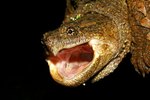Things You'll Need
Live food
Sandy soil
Pond
Aquarium
Aquarium heater
Floating log
Aquarium filter
Fish food
Trout pellets
Fresh smelt
The wild painted turtle (Chrysemys picta) lives in virtually every region of the United States, some parts of Canada and some areas of Mexico. The turtles measure 4 to 10 inches when fully grown and have an average lifespan of 20 years. They are found in freshwater bodies of water such as ponds, lakes and creeks. The turtles are commonly seen in large groups basking on logs. Many people enjoy caring for wild painted turtles in their backyard ponds, aquariums and fish ponds.
Maintain an environment as close to the wild habitat as possible for the wild painted turtle to thrive in. Young wild painted turtles are predators who subsist solely on snails, slugs, tadpoles, tiny fish, crayfish and insects. Make sure that these are provided in your backyard pond to help feed the young wild painted turtles. A turtle will not reach adulthood until it is 5 years old. As the turtles age they become omnivores that can survive on a wide range of animal and plant life.
Provide ample sandy soil around the pond or creek for the wild painted turtle females to nest within. Each spring the female will prepare a nest beside the body of water to lay her eggs. The sandy soil will need to be moist for the turtle to successfully nest within. The area should be sunny for incubation to easily occur. The female will lay between 2 and 20 eggs which take 76 days to hatch. Once the eggs hatch the baby turtles make their way to the water.
Place baby painted turtles into an aquarium if you wish to make one a pet. The turtle needs to have an aquarium with other painted turtles since they are very social in nature. Three turtles can live in a 4-foot long aquarium that offers filtration and heat. There should be a floating log for the turtles to climb aboard, sand for the turtle to lie on and aquarium plants that are non-toxic. The baby turtles will need to be provided with live food such as feeder fish, worms and meal-worms. As the baby painted turtles age you will be able to introduce fish food, trout pellets and fresh smelt into their diet.
Tips
Turtles do not like being handled very often. Turtles can be completely frozen and still live. If the pond freezes completely do not worry about the wild painted turtles.
References
Photo Credits
-
Painted Turtle image by Jim Mills from Fotolia.com
Writer Bio
Based in Oregon, Kimberly Sharpe has been a writer since 2006. She writes for numerous online publications. Her writing has a strong focus on home improvement, gardening, parenting, pets and travel. She has traveled extensively to such places as India and Sri Lanka to widen and enhance her writing and knowledge base.





